Shiver Me Space Timbers
|
This article first appeared on in70mm.com The 70mm Newsletter |
| Written and photographed by: William Kallay | July 2002 |
|
|
Further in 70mm reading: LFCA 1999 LFCA 2000 LFCA 2001 Bill Kallay also wrote: Final curtain for the Cinedome, Los Angeles, USA and Director Shows 70mm 3-D At LFCA |
Disney Increases Large Format Production |
|
 "Horses: The Story of Equus" "Horses: The Story of Equus"Disney treated the LFCA audience to a number of clips and previews of its upcoming large format productions. Senior Vice President of Worldwide Special Events, Lylle Breier, introduced the clips, which included "Treasure Planet" (late 2002), a space update on Robert Lewis Stevenson's classic book, "Treasure Island"; "The Lion King" (December 25, 2002) and "The Young Black Stallion" (2003). Each of those films will be presented in IMAX and Giant Screen theatres in an aspect ratio of 1.66:1. There have also been tests done on "Aladdin" (1992) and "Tarzan" (1999) in large format, in which clips were shown. Disney picked up the North American rights to James Cameron's 3-D large format film, "Ghosts of the Abyss". Breier would not divulge any other details about the film, other than it still was being worked on. All of the clips were high quality. Imagery was sharp and defined; something to be expected out of IMAX 15/70 film. Treasure Planet shows promise as an entertaining giant screen movie. "The Lion King" looks very impressive on the IMAX screen. The 1994 film suddenly gains more epic splendor on the big screen, especially during the wildebeest stampede sequence. Still, Disney has many members of the large format community to win over. Many of the venues for large format are located in museums, science centers and educational facilities. Showing a film such as "Ultimate X" (2002), or "Treasure Planet", doesn't necessarily fit the theme of education. It was pointed out by Breier that Disney will be releasing "The Young Black Stallion" with educational books and other materials. On the other hand, some people commented on the fact that some of the fine animation just doesn't seem to fit well on such a large screen. But one of the main themes seemed to be that a large corporation, whoever it may be, was stepping into an industry that is much different from Hollywood. "People may debate commercial versus industrial use of large format, and that debate will never be resolved. People have opinions," said Leonard Maltin, during his keynote address. "And as the commercial movie-makers muscle their way into this business, they're going to have more to say about what gets shown. They'll affect the box office and the almighty dollar rules everything, as we all know." |
|
So "This Is Cinerama" Before Our Eyes |
|
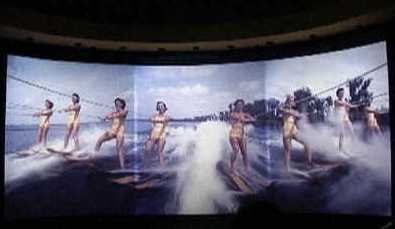 Screen shot of "This is Cinerama" Screen shot of "This is Cinerama"
One of the treats of an LFCA conference is getting the opportunity to see films or film formats which inspired large format filmmaking. In the past, there have been showings of 70mm prints of "Lawrence of Arabia", world's fair films and experimental films. This year is the 50th Anniversary of Cinerama, the 3-strip film process that started the widescreen race in the 1950s, spawning formats like CinemaScope (1953), Todd-AO (1955) and Super Panavision (1959), to name a few. Pacific Theatres, which owns Cinerama and the Cinerama Dome in Hollywood, recently struck new prints of the seminal film. It was also the first time a 3-strip Cinerama film was shown in the newly refurbished Dome, which now includes the ArcLight Cinema complex. |
|
 Members of the LFCA gather in the
Cinerama Dome lobby. Members of the LFCA gather in the
Cinerama Dome lobby.After an interesting introduction to film history from Lowell Thomas, the curtains opened to "This Is Cinerama". The audience clapped. For a 50 year-old film, " This Is Cinerama" still packs a punch from its famous roller coaster ride sequence. The soundtrack is clean and has a punch to its bass. The three separate prints were in good condition and brightly illuminated on the huge Cinerama Dome screen. By watching the film, one can see its obvious influence on other formats, just not from a technical aspect, but from other aspects, as well. The film ushered in the era of the roadshow; widescreen filmmaking and presentation; the re-introduction of large format film; travelogues on a large screen. For an audience made up of members from the large format community, it was a special treat to see the film that started it all, "This Is Cinerama". |
|
IMAX's DMR |
|
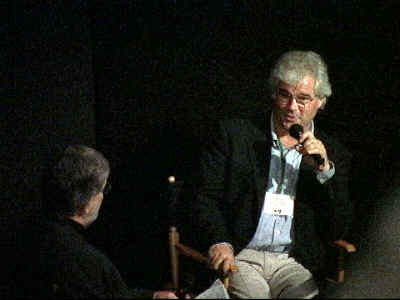 David Keighley of DKP 70MM Inc. (left) and
Kodak Vision Award Winner, David Douglas David Keighley of DKP 70MM Inc. (left) and
Kodak Vision Award Winner, David DouglasUniversal Studios, Imagine Entertainment and IMAX recently unveiled their plans to re-release the 1995 film, "Apollo 13", in IMAX later this summer, re-titled as Apollo 13-The IMAX Experience. The film went through IMAX's proprietary software process, DMR, to enlarge and de-grain the Super 35mm images for presentation on the IMAX screen. In addition, the 2.40:1 aspect ratio has been re-worked into 1.66:1. From widescreen to the big & tall screen? How does this look? Obviously, " Apollo 13" wasn't filmed in 15-perf/70mm, but it shows that the DMR process has the potential of bringing other 35mm films to the IMAX screen. The preview that was shown was impressive, if one takes into account the source material came from a Super 35 negative. Most audiences, of course, probably won't notice the difference between this process and true 15/70. But for some in attendance, the difference was obvious; Super 35 is not 15/70, no matter how much it's degrained. However, over the past few years of my attendance at LFCA, I've seen many large format films made from different film, photographic and video elements. A lot of those formats, which may include 35mm and standard definition broadcast video, are scanned at high rates into computers and digitally fixed or augmented. The work performed by companies like Imagica USA, DKP 70MM Inc. and IMAX is extraordinary and could offer a better way for audiences to see 35mm originated films on screens meant for 8/70 and 15/70. In the Los Angeles region, many commercial theatres that have a giant screen (8/70) or IMAX screen have been showing 35mm prints of current box office hits on their giant screens. The result is "enhanced 35mm" on giant screens. The prints are no more than 35mm prints pumped up with extra light during printing. They look poor and mislead audience members into thinking they are seeing an IMAX or Giant Screen film that fills up the entire screen. At least with DMR, most of the screen is filled with a bright 15/70 print. |
|
Leonard Maltin Speaks Up For Quality Presentation |
|
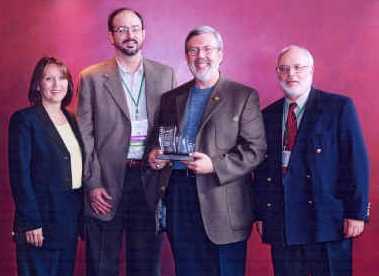 Charlotte Huggins, Robert Dennis, Leonard Maltin and Christopher Renya Charlotte Huggins, Robert Dennis, Leonard Maltin and Christopher RenyaLeonard Maltin, film historian, critic and author, was the keynote speaker at LFCA this year. Maltin has been known for years to be one of the most knowledgeable individuals on the history of film. He's written fascinating books on animation, the subject of Disney and has consistently updated Leonard Maltin's Movie and Video Guide. He spoke about his experiences in seeing movies at the movie theatre. It seemed that one of his pet peeves was seeing movies slightly out-of-focus. At one showing, he got up out of his seat and spoke to a theatre employee about the film being out-of-focus. The employee replied, "Well, no one else is complaining." Maltin praised the large format industry for its consistency in keeping quality presentation in front of paying audiences. "There aren't many areas of film where you can truly say that quality is king, but I think this is one of them. My hat's off to everybody who works in this field, and is always pushing for new levels of quality, new standards, new equipment and ways new ways to excite and enlighten and educate and dazzle an audience," said Maltin. |
|
New and Vintage Large Format Movies |
|
|
The winner of the LFCA "Best Film of Festival Award" went to "Space Station" 3-D, which was certainly an audience favorite. The film, narrated by Tom Cruise, takes us earthbound citizens to the International Space Station, hovering 250 miles above the planet. This is one of the most spectacular and fun IMAX films ever made. The IMAX 3-D process puts audiences right into the Space Station with the astronauts. The astronauts themselves filmed the film while in space. They were taught how to shoot on new IMAX 30-perf cameras by cinematographer, James Neihouse, who also co-produced. Other films shown at the conference included "Australia: Land Beyond Time", "The Trip" (a short 15/70 Best of Festival winner), "Kilmanjaro: To The Roof of Africa", "In Five Minutes, the Feature" (short), "The Human Body", "SkyDance", "Lewis & Clark: Great Journey West", "Pathways to Quality" (a ride film for Volkswagen's Germany theme park), and "Horses: The Story of Equus". In 1967, acclaimed French director, Jacques Tati, shot his film, "Playtime", in 65mm, an unusual decision since the only other comedies to be shot in the format were "It's A Mad, Mad, Mad, Mad World" (1963) and "The Hallelujah Trail" (1965). The film has been restored by Gulliver, a film lab in France, and will be re-released in that country this year after its premiere at the Cannes Film Festival. Apparently, no plans have been made to re-release it in North America this year. Only one reel was shown in the IMAX auditorium. The scene had a traditional lighting design featured in Blake Edwards' "The Party" (1968), casting a bright, late-sixties look upon the cinematography. Though the film stock is older and somewhat dated, the 70mm print is brilliant. According to a representative from Gulliver, Tati shot it with 65mm cameras (Mitchell) with the sides of the 2.21:1 masked down to 1.85:1 to enable the use of a then-new 8-track stereophonic sound playback system. It wasn't clear whether the film was shown with that particular soundtrack, however. |
|
Achievements in Large Format |
|
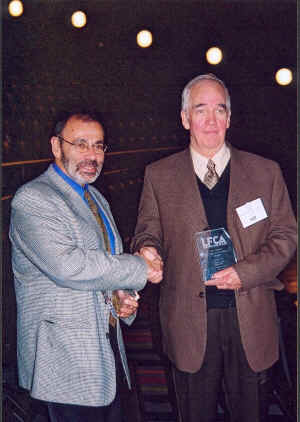 Jacques
Bensimon of the National Film Board of Canada (left) and Colin Low (right)
with LFCA award. Jacques
Bensimon of the National Film Board of Canada (left) and Colin Low (right)
with LFCA award.The LFCA honored both members and films during the conference. Cinematographer, David Douglas, was given the Kodak Vision Award for his outstanding work in large format filmmaking. Some of his camerawork includes "Rolling Stones: At The Max" (1991), "Fires of Kuwait" (1992) and his most current work will be featured in "STRAIGHT UP! Adventures In Vertical Flight". Douglas, like many of his fellow large format filmmakers, has risked his own life in the harshest of the world's environments to film these movies. He shot footage of 2000-degree oil fires in Kuwait, only a few feet away from the flames, trained astronauts how to operate IMAX cameras in outer space and braved thousands of Stones fans to film Mick Jagger. Stanley Kubrick couldn't have done it without Colin Low. Many of the images in the Stargate sequence of "2001: A Space Odyssey" (1968), were influenced by Low's 1960 film, "Universe" (co-directed by Roman Kroitor). Low is an influential filmmaker from Canada who has shot a number of experimental animated shorts, documentaries and special venue films like "Into the Labyrinth" (1967), which influenced the creation of IMAX. That film was shown during the 1967 Expo in Montreal and featured both 35mm and 70mm images. The LFCA awarded the annual Abel Gance Award to Low, as well as to Canada's National Film Board (NFB), for outstanding work in the large format field. |
|
Conclusions About LFCA 2002 |
|
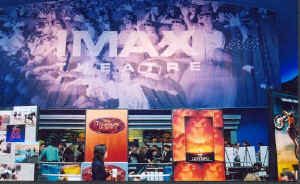 Universal CityWalk IMAX Theatre lobby Universal CityWalk IMAX Theatre lobbyMany aspects about the LFCA Conference have remained the same over the years. Tradition versus new opportunity continues to be a topic of discussion. It was difficult to discern if the industry was embracing further commercialism from Disney and Universal, or if it was shunning it. "They are throwing a lot of things into the business," said Andy Gellis of Cinevest, "The dynamic has changed." Is the large format industry reluctantly delving into the world of commercialism in order to survive? Will it lose its soul of making some very good documentaries? Most large format films don't do spectacular box office, and many that do perform well take considerably more time to do so. They are played in far fewer theatres than commercial films, normally contain subject matter, which aims to educate audiences and normally don't have much advertising. Thus, it's difficult to compete in a market where Spider-Man dominates nearly every multiplex cinema in town with entertainment in mind, and the advertising dollars to boot. On a summer Friday night, for example, is the average teenager going to opt spending $9.00 on Spidey, or $11.00 on a large format 40-minute documentary? Audiences have answered that question by buying tickets to see films on large format screens. Only, those films aren't the usual large format fare of airplane flights over the Grand Canyon or historical lessons in American history. They're the "enhanced 35mm" prints of Spider-Man which are keeping commercial theatre operators happy about the investment in a giant screen in their complexes. It's not surprising to see, at least in part, the industry embracing the likes of Disney or Universal for further revenue and exposure. It's difficult to argue with the extra publicity that these and other major studios could provide. But it goes beyond that, in some ways, too. The large format screen doesn't necessarily have to be constrained in content or creativity. Hollywood can offer budgets, which could make certain movies viable in large format. Imagine if Spider-Man was shot in large format, even in 8/70, like The Adventures of Spider-Man attraction at Islands of Adventure theme park in Florida? The results could've been wonderful in large format. |
|
However, there are many within large format that are sticking to their principals of making high quality films that are not commercial. One thing remains clear about large format industry veterans, in general; they're a passionate bunch of individuals who love their work and their industry. This isn't a group which makes films on $100-plus budgets, or has a number of trailers waiting for them after a morning's shoot. It's a group of people, such as producer/director Mark Merrall and his crew making the film
"Manatee: The Forgotten Mermaid", funding camera rentals and buying film stock on their own credit cards. This isn't that unusual in low budget independent filmmaking. But try getting good footage of a manatee in the wild, while floating in your scuba gear in the Florida water with a huge IMAX camera.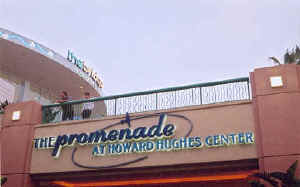 The Bridge Cinema de Luxe in Los Angeles The Bridge Cinema de Luxe in Los AngelesWhat does the future hold for the large format industry? The large format industry has reluctantly been engaged with some major studios, much to the dismay of some of its family members. Now it appears the industry is heading down the aisle with not one, but two major studios. Whether or not this fairly new "marriage" will work for either the large format industry or for the big studios is unknown. Disney has had success with the releases of "Fantasia 2000" (2000) and "Beauty and the Beast" (2002), enough for the studio to invest in more large format projects within the next two years. And now, Universal is jumping onboard. As for the large format industry, it hasn't had a hit on the scale of "Everest", which came out in 1998. "Space Station 3-D" and "Ultimate X" have given it positive signs of financial success, but so far, nowhere near megahit status. |
|
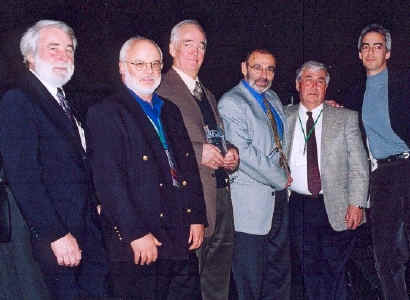 Left to right: Ernie
McNab, Christopher Reyna, Colin Low, Jacques Bensimon, Tony Ianzelo, Alex
Low. Left to right: Ernie
McNab, Christopher Reyna, Colin Low, Jacques Bensimon, Tony Ianzelo, Alex
Low. The large format industry and the major commercial studios are two different entities. One is independent and mostly wants to focus its entertainment on a select audience; the other wants to please nearly everyone in the paying audience. It's a marriage fraught with uncertain goals for both parties. The studios can stand to earn good-to-great box office revenue on re-issues of its classic animated films or live action films. The cost of "re-purposing" computerized files or 35mm is about $2-3 million. However, the large format industry potentially has more to lose. What if its reputation for presentation is somehow tarnished by the inclusion of projectionists who don't care about quality? Could the name brand recognition of IMAX tied with Disney or Universal confuse audiences seeking educational films? Could there be a loss of identity for the large format industry of being the supplier of educational films? Hopefully, the partners in this marriage will make adjustments to help the other succeed in the film business. But one thing is for sure; the major studios wouldn't hurt too much if there were a divorce. There's always another Spider-Man-type film waiting in the wings to make up for losses elsewhere. The large format industry doesn't always have an "Everest" to do the same thing. |
|
| Go: back
- top - back issues Updated 22-01-25 |
|

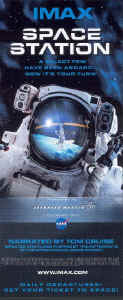 Space Station 3-D
Space Station 3-D